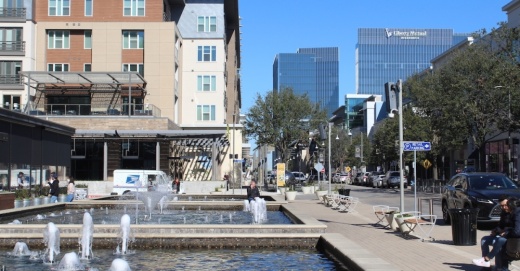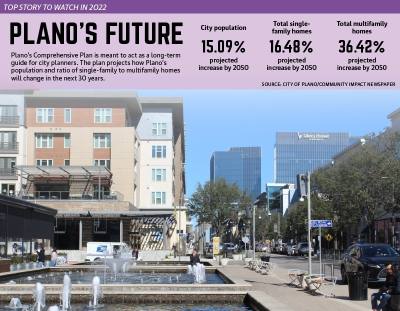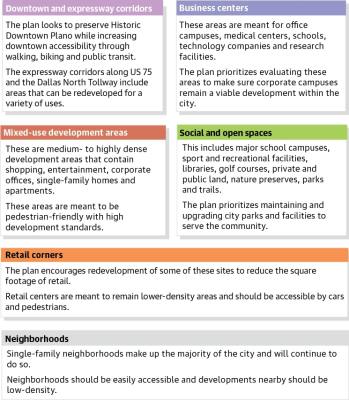“I appreciate everybody compromising to a certain degree,” Mayor John Muns said. “We finally have a plan that we can work with.”
The plan is a long-term guide that focuses on future growth, priorities, services and development in Plano, according to the city’s website. Officials have been following guidelines from the last comprehensive plan since it was approved in 1986.
The new plan can be viewed at www.planocompplan.org and can be used by residents, city officials and businesses in a variety of ways.
According to the plan’s description, residents can use it as a reference to see how the city will guide growth and redevelopment moving forward. Businesses can use it when deciding to invest or relocate to Plano. City officials will consult the plan when making decisions about how to use city resources and which areas might be best suited for new office, commercial or residential developments.
Plano Director of Planning Christina Day said the new comprehensive plan is a roadmap for the city to make strategic, long-term decisions rather than having to react to circumstances.
“[It] guides various key elements for the health and well being of the community,” she said. “[The plan covers] development, the economy, the environment, [and] social and regional concerns.”
Guiding pillars
The plan has a specific vision with separate guiding pillars. Those consist of five main sections: land use, housing, redevelopment, city growth and transportation.
The plan states Plano has less than 5% of undeveloped land available. It also says the city’s population is likely to grow only about 15% higher than its current total of 287,000 residents.
The plan projects the city’s population by 2050 to be near 331,000. By that same year, it also predicts 60% of residences will be single-family homes with the remaining 40% to be multifamily housing.
The plan also has a variety of maps to help city planners in land use, transportation and development decisions.
Doug Shockey, chairman of the Comprehensive Plan Review Committee, said drawing the lines between areas of suburban and urban development was challenging.
“We need affordable housing,” Shockey said. “But the challenge was how to add these things in a suburban character.”
The land use map identifies areas around Legacy West; the Dallas North Tollway between Spring Creek and Plano Parkway; The Shops at Willow Bend; US 75; Oak Point Park; the intersection of 15th Street and Alma Drive; and downtown Plano as being the most likely places for more multifamily housing.
Day said it was crucial for the new plan to be adopted by City Council as soon as possible because it acts as a broad piece of direction for action from City Manager Mark Israelson and city staff members.
For example, she said, one section of the plan gives staff direction to work with property owners across the city to find retail centers that are candidates for redevelopment.
“Because that’s an adopted policy, the city manager can [now] direct us and say, ‘I’m going to set up a staff task force to go and start working on it,’” she said.
Moving ahead
An earlier version of the guide, called the Plano Tomorrow Plan, was voted down by council in August 2020 after a lengthy legal battle. Some residents voiced concerns that the earlier version was too focused on apartment development and increased density.
Council then formed the 16-member Plano Comprehensive Plan Review Committee. Each council member was allowed to appoint two members to the committee.
Charged with making revisions to the Plano Tomorrow Plan, the group members’ diverse backgrounds, and the input they received, made the plan stronger, Shockey said.
Council unanimously approved the new plan in November following 15 months of work.
Shockey said community engagement is a key aspect going forward. It can be updated when needed and residents can provide consistent feedback.
“We wanted to make sure that going forward, all parties have equal access to the process,” Shockey said. “The opportunity for [everyone’s] input is what pushed this thing to being a major success.”
Plano resident Steve Lavine said the plan is not perfect, but it is a step in the right direction.
“It certainly does not include everything I thought it should include,” he said during public comments at the Nov. 8 town hall. “But it is a great set of guidelines that we needed.”
Day said the previous maps used for the Plano Tomorrow Plan were based more on policy while the new maps are primarily based on data.
“It is intended to establish clear community expectations that help guide and manage development,” she said. “This plan is much more precise in what changes can occur and where.”
One example of that is in the plan’s redevelopment and growth management section. It states that in a request to rezone an area for a mixed-use development, no more than half of the proposed square footage should be used for residential housing.
Being flexible
While the plan’s direction seems rigid, the mayor said it will be important for city planners to evaluate each zoning case on an individual basis.
That was the case on Dec. 7 when council approved a zoning change that will bring a large, mixed-use development to more than 2 million square feet of land owned by the Haggard family near the intersection of Spring Creek Parkway and Parkwood Boulevard.
The request was submitted under the 1986 plan, but some residents and council members argued that approving it would be inappropriate since the new comprehensive plan’s future land use map suggests that area is best used for open and recreational space.
Council ultimately voted 5-3 in favor of the zoning change.
Muns said that decision is an example of why it is important for the comprehensive plan to be flexible.
“Let’s not assume that we are going to be too rigid; we need to make sure it benefits the city,” he said.
The changing demand for office and retail space in recent years, Muns said, is another reason the city must have an adjustable plan moving forward.
“We just want to make sure that we’re giving the city and future [councils] ... the flexibility to make decisions on what the market demands,” he said.








